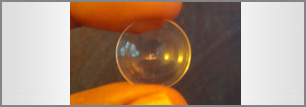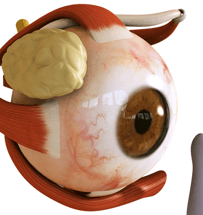

The Chandra Scleral Lens, a highly oxygen permeable rigid (120 DK) contact lens device the size of a 50 paisa, is designed to rest on the tough relatively insensitive tissue of the eye called the sclera. By enclosing an artificial tear-filled space over the diseased cornea, the most sensitive tissue of the human body, it functions as a soothing and healing liquid bandage that relieves the pain and light sensitivity of severe dry eyes and chronic corneal inflammation while encouraging the healing of erosions and ulcers even when all other treatments have failed. 
Indications for Chandra Scleral Lenses
- Relief of pain and photophobia in Steven-Johnson Syndrome (SJS)
- Toxic Epidermal Necrolysis (TEN)
- Treatment and prevention of persistent epithelial defects (PED)
- Severe Dry eyes includes
- Chronic Graft Vs Host Disease (GVHD)
- Sjogren’s Syndrome
- Keratitis Sicca
- Keratoconus
Fitting Procedure
The fitting process of Chandra Sclerals is an empirical process based on the fitting characteristics of the series of diagnostic lenses. The radius of central optical zone is chosen so that an adequate layer of fluid separates this surface from cornea as determined by scanning a parallelepiped beam of slit lamp from limbus to limbus. Vault and central base curve is selected so that approximately 120µ space can be maintained between cornea and lens back surface after the lens is worn for minimum 2 hour.
The AutoCAD program enables the fitter to manipulate the clearance of any segment of the posterior haptic surface to avoid sealing the fluid compartment. The fitting protocol requires the clinician to confirm the functionality of tear-fluid interchange by observing the passage of fluorescein dye from the tear pool outside the lens under the haptic and into the fluid compartment while excluding the intrusion of air bubbles. The competence of a lens to satisfy these two criteria is evaluated after a wearing period of 1 to 2 hours to allow the lens to settle fully.
Over acceptance is done once fitting criteria are fulfilled. After vergence correction the power is added to the diagnostic lens power for the final lens that is manufactured.
Contraindications and limitations
Except for the treatment of PED, scleral lens fitting is delayed until the inflammatory condition of the ocular disease has subsided sufficiently in the normal course of the disease or by medical treatment. The timing for fitting these lenses is determined by the patient’s response to a wearing trial. In case of discomfort and significantly increased bulbar conjunctival redness, the fitting process is postponed.
Cicatricial conjunctival changes and the presence of a symblepharon often require the lens design to be adapted to anatomic changes induced by compromised fornices. Fitting the largest possible scleral lens does not prevent the recurrence of incised symblepharon, however, this rarely presents an obstacle to the successful use of these lenses. The additional challenges posed by the need to fit smaller scleral lenses usually can be overcome by customizing the lens design.
Tear-fluid interchange is key to the wearing tolerance of fluid-ventilated, gas permeable scleral lenses, and the presence of a visible tear meniscus is mandatory. When natural tear production is reduced due to certain ocular conditions, goblet cell secretions often remains normal that causes mucous debris accumulating in the tear pool, requires frequent removal of the lens for cleaning and filling with fresh artificial tears (or normal saline) to maintain clear vision.
Risk of bacterial keratitis is more when lens is worn on extended wear basis in case of PED or along with topical steroids. This must be weighed against the potential benefits for each patient.
Availability of technical know-how and materials plus need to customize and design individual lens makes it difficult to transfer the technology to regular contact lens practitioners making treatment with Chandra Sclerals possible to patients at few centers all over the world. At present apart from USA the lenses are available in India at Shekhar Eye Research Centre Ophthalmic Pvt. Ltd. in Mumbai and a few other centers set up by Chandrashekhar Chawan globally.
Summary
Chandra Scleral Lenses are a valuable frontline tool in the management of severe ocular surface disease. It acts as a liquid bandage lens over diseased cornea and enhances vision along with giving relief from disabling pain and photophobia associated with SJS, TEN and ocular cicatricial pemphigoid. It can avoid or lengthen the time required to perform Penetrating Keratoplasty for Keratoconus patients. Chandra Sclerals is also useful in treatment strategies of PED and stem cell deficient and neurotrophic corneas. The oxygen-rich aqueous environment that is created over corneal surface provides the therapeutic benefits of these lenses. This oxygenated pre-corneal fluid compartment, which is maintained at neutral pressure, protects epithelial surface from desiccating effects of exposure to air and friction generated by blinking. Irregularities of the corneal surface are neutralized due to this aqueous giving enhanced vision.
 OUR SPECIALIST
OUR SPECIALIST
 our products
our products

- 3D Custom Made Artificial Eyes
- Keratoconus
- Oculoplasty
- Orthokeratology
- Speciality Contact Lens
- Chandra Scleral Lenses
- Myopia Control
- Gold Contact Lenses
 phone
phone
 email
email

 buy online
buy online
.jpg)
.jpg)






